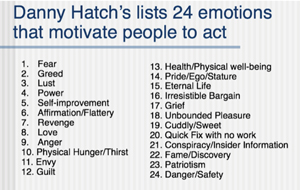 By Billy Sharma
By Billy Sharma
The answer is a resounding “YES!”
Direct mail is referred to as “salesman in print” for a very specific reason: it allows you to make your pitch or tell your story, long or short. However, direct mail will only work as hard as you do — if it is done in the proper way, to a good list, with a compelling offer, and with targeted and persuasive creativity.
Having created hundreds of successful direct mail packages for all the companies listed alongside, here are some of the rules that I have learned from others and from my own experience:
1. Get to the point immediately.
You must get to the point, and the offer — faster than ever before. People no longer wait patiently for the “punchline”.
Here’s proof: the classic Wall Street Journal two-page letter, that raised a million dollars for the Wall Street Journal, was finally beaten (after 32 years!) by a simple list of everything you received with your subscription.
2. Bullet-proof your information.
People have very little “disposable attention” today and only spend it on things that really interest them. So, organize the information for them. Lists and bullet points are extremely effective. Side bars work well. So do short sentences, small paragraphs and white space. By the way, these rules also apply to emails. Above all, be clear about exactly what you want them to do — and why they should do it — now.
Example: What catches a reader’s attention?
- The salutation
- A headline or Johnson box
- A captivating first sentence (keep it short; no more than 10 words)
- Underlines: in direct marketing, use sparingly; in viral marketing, underline only words as hyperlinks
- Bolded or italic sentences (use sparingly)
- Bulleted lists
- The closing
- Who signed it or the sender
- The P.S.
- Images (with captions or inserts)
- Free offers
- Things to click on. This applies to the numerous links to the donation page in viral marketing.
- Interactive features: in direct mail use scratch cards, involvement devices, a quiz, etc. In viral marketing use a button to click on to forward to a friend.
3. Attraction is Not Enough.
Once upon a time, a great opening sentence or headline was enough. And of course, you still need one. But today, you don’t just need to attract their attention you need to keep their attention — sentence by sentence, paragraph by paragraph. Otherwise, people get bored.
A Covenant House letter did that in spades. Email me and I will send you a copy.
4. An Added Dimension.
Direct mail is the only medium I know where you have three dimensions to work with, and no limits on how much information you can provide. It allows people to hold the product or your marketing material in their hands.
5. E is for Engagement.
Without engagement you are not getting that stickiness to hold your reader’s attention. For example: The International Rescue Committee (IRC) raised millions for Refugees. They used videos on their social media sites and on their website and even had links to it in their direct mail material. They were successful in spreading their emergency messaging, resulting in over 7 million views, 57 million impressions, and a 90 percent awareness.
Here’s the VIDEO LINK: https://youtu.be/JfQTFD_5CX8
6. Easy Reading.
Make sure that the width of the letter is designed for optimum legibility.
Use wide margins, so readers narrow their focus on the copy. Short columns are easier to scan. Keep your copy width down to sixty characters or less — that’s about six inches, maximum. Think paperback novels. Beyond that width the reader needs to move his head back and forth horizontally, making reading more difficult. It can also literally be a pain in the neck.
7. Add Photos to Tell a Story.
Example: Move the letter to one side and add a sidebar with a testimonial from someone who benefited from your organization’s good work. Or add a tear-off column with helpful tips or a schedule of upcoming events.
8. Promises, Promises.
Remember, we are not just selling a product we are also selling a promise.
Good writing in our business is not academic writing, but persuasive writing. Forget what you learned in school about good grammar, direct marketing, or fundraising copy. Your words should sound like someone talking — like a conversation with the reader.
 Example: Danny Hatch listed several emotional copy drivers. He said that if your copy isn’t dripping with one or more of these tear it up and start all over again.
Example: Danny Hatch listed several emotional copy drivers. He said that if your copy isn’t dripping with one or more of these tear it up and start all over again.
Today, these copy drivers are considered as neuroscience since they engage the primal brain releasing dopamine or one of the hormones that stimulates interest. Emotions are the biggest factors that make us buy or want a product or donate to a cause.
Five major stimuli
- “You-centricity”—“what’s in it for me?”
- Contrast: black and white, new versus old. That’s why comparison tables are extremely effective.
- Texture, tactility. It’s the only channel we have to awaken one of the senses that isn’t often used: make your readers feel bumpy, lumpy, odd shapes, and all that sort of stuff.
- Tangibilty, touch. It’s real, it’s physical. It can do things. And in print, we can have things pop up; we can have things unfold. Every time we get that involvement of the real, especially in direct mail or where things are unfolding with pieces and multiple elements—that’s giving us time of consideration.
- Emotionality happens through story and through picture.
9. Relevancy.
Finally, it’s not just personalization that attracts, it’s relevancy. Example: The Environmental Defence Fund put together an interesting little quiz called Earth Day Jeopardy. Rather than go on and talk about the issues to their donors, they challenged them to take a few minutes to test their knowledge. It is a great engagement idea with plenty of value.
Another great example: After the recent controversial Supreme Court of the United States decision on abortion, the charity, National Organization for Women (NOW), sent an invitation to their donors to go to a planning meeting in the town right next door. Sometimes charities seem to forget the incredible power to “localize” their brand. This was a great example of doing it right.
Billy Sharma is President & Creative Director of Designers Inc. He started his career in the advertising world and have worked in four major cities — Munich, Montreal, New York and Toronto for some of the largest advertising agencies. For the past three decades he has run his own company, Designers Inc.




